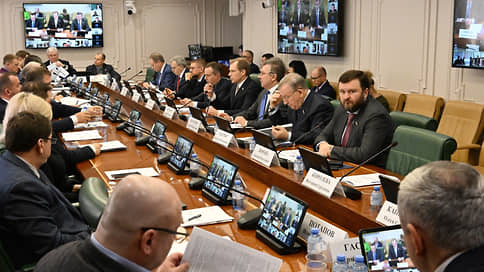Autocitizen enters the new reform – Newspaper Kommersant No. 58 (7503) dated 04/05/2023
[ad_1]

Motorists should get ready for a new portion of changes in the field of OSAGO. The details of the forthcoming reform were discussed in the Federation Council on Tuesday. The Ministry of Finance, in particular, called for an increase in the fine for the absence of a “car citizen” from 800 rubles. up to 5 thousand rubles The Russian Union of Motor Insurers (RSA) plans to start connecting road cameras to check policies at the end of the year, fines will come once a day. In parallel with this, the PCA, the Ministry of Finance and the Central Bank are discussing the possibility of using used spare parts for OSAGO repairs, since prices for new spare parts are rising, there are problems with their supply. Independent experts have criticized the proposals of the authorities and insurers.
The details of the next reform of OSAGO were discussed on Tuesday at a meeting in the Federation Council: the head of the committee on economic policy, Andrey Kutepov, outlined the main problems in the industry.
According to him, many car owners against the background of declining incomes are tempted to drive without a policy.
It is easier for a motorist to pay a fine of 800 rubles several times a year than to pay for the entire insurance, Mr. Kutepov explained. The price of insurance can reach 20 thousand rubles. for a certain category of drivers. It is necessary to connect traffic police cameras to OSAGO control, Andrey Kutepov said, especially since the number of traffic police officers has decreased in recent years. Deputy Finance Minister Alexei Moiseev proposed raising the size of the sanction to 5,000 rubles. He recalled that driving without a policy is considered a “continuing” violation, so it is impossible to send a ticket for driving without insurance under each camera. Mr. Moiseev believes that this restriction could be lifted. “I drove from Moscow to Ryazan and “clicked” on the cost of the policy. Then, in principle, the fine can not be increased,” he believes. If the cameras provide 100% control, then the number of insured people will increase, which will lead to lower insurance rates for accident-free and accurate drivers, he suggested. O. director of the insurance market of the Central Bank Ilya Smirnov.
Evgeny Ufimtsev, President of the Russian Union of Motor Insurers, recalled that a working group has already been created under the leadership of the Central Bank, which deals with issues of automatic fixation of OSAGO.
As reported by Kommersant in mid-March, insurers plan to first check the policies through cameras not for all cars caught in the lens, but only for violators (so as not to overload the databases). This approach was supported by Ilya Smirnov from the Central Bank on Tuesday. Mr. Ufimtsev expects that the automatic check of policies will begin by the end of the year: it is necessary to “slightly” refine the traffic police systems. Previously “Kommersant” told that the revision requires the conclusion of a separate contract, which is unlikely to be executed before 2024.
The topic of the use of used spare parts for OSAGO repairs was also discussed (now this is formally prohibited). Evgeny Ufimtsev recalled that there is now a problem with the supply of components, their prices have increased by an average of 30%, this is especially felt when repairing right-hand drive cars (there are more than 3 million of them), for which there are no new parts at all. Deputy Finance Minister Alexei Moiseev considers it acceptable to use used spare parts, but not all. “It is clear that the brake pads cannot be used, but the headlights probably can,” he said. The installation of such spare parts can be allowed provided that it does not endanger traffic safety, Ilya Smirnov added.
The independent experts invited to the meeting were skeptical about the proposals of the departments and the RSA. The President of the Moscow Transport Union, Yuri Sveshnikov, said that many commercial carriers want OSAGO, but insurers refuse to conclude a contract under various pretexts or agree only after paying for additional services (for example, subject to driver’s life insurance). Before raising fines, it is necessary to create a system that would record carriers’ appeals to insurers and their refusals, Mr. Sveshnikov believes. Ordinary car owners have the same problems, Anton Shaparin, vice-president of the National Automobile Union, confirmed: “There is a practice of avoiding the sale of policies throughout the country, and we do not understand why the Central Bank does not take any punitive measures.”
The expert is sure that it is impossible to strengthen control over OSAGO until all issues with OSAGO repairs and payments are resolved.
According to him, only 5% of cars are repaired in car services within the framework of the “car citizen” (that is, in the direction of insurers), the rest of the companies pay money, which in most cases is not enough for repairs, although the price of the policy is growing (according to the Central Bank, by 17% in 2022). The fact that payments are often not enough to pay for repairs was also confirmed by Ilya Plisov, a member of the board of the Union of Car Services: the problem is in the price guides for spare parts used by the PCA – they need to be updated not once a quarter, as now, but once a month. “More and more people are ready to give up and refuse OSAGO, and you won’t drive them back with fines,” said Mr. Shaparin. According to the PCA, in 2022, 4% fewer policies were issued. However, Evgeny Ufimtsev explains this by a drop in car sales due to the withdrawal of Western car companies.
[ad_2]
Source link








